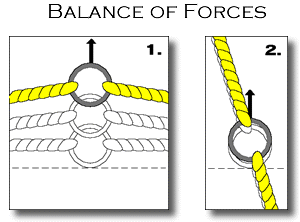We have described the inertia of the body’s systems by using the example of a ring with ropes tied to it, with each rope pulling with a different tension such that all the tensions in the ropes balance out in such a way that the ring maintains a certain position. In those simple analogies, we have imagined the balancing of only a few forces. However, we can see that there are many systems in the body and many forces at work that influence the overall balance or position of the body. So rather than just a few ropes or forces at work, there are actually many more, a few of which we have mentioned (female hormone, adrenal hormone, thyroid hormone, glucose metabolism, stress, body shape, diet, exercise, medications, etc.).
Frequently, the overall balance can be favorably normalized with the WT3 protocol. The WT3 protocol can seemingly “pull” the thyroid system and consequently even other body systems and forces into a new balance or position. This “settling” may explain why symptoms sometimes continue to improve even after steady state has been reached (in about two weeks) or even up to six weeks or more.
Theoretically, the overall balance could possibly be manipulated through the manipulation of other systems other than the thyroid system. the WT3 protocol may be so much more useful, effective, reproducible, and predictable because of the fewer number of variables involved. Just as it is easier to turn on a light switch with one end of a ruler while holding the other end, than it is to turn on that switch using a segmented bamboo toy snake that flops or “writhes” when one holds it out by the tail against gravity. The greater the number of variables or “segments” the more difficult it is to control a tool in the accomplishing of a specific purpose. The female hormone system, for example, involves progesterones and estrogens that go up and down independently, at different times of the month. There are many different forms of estrogens and progesterones on the market, both separately, and in different combinations. Such a complicated set of variables would be, to say the least, extremely difficult to manage effectively, even if the female hormone system could be manipulated to change the overall balance of the body.
Since the overall balance of the body’s system can usually be restored to a desirable position with the WT3 protocol, when progress seems to get “stuck” in terms of a lack of continued improvement in the symptoms of MED during the process of cycling, one might look for “opposing” forces that may be resisting further progress. Referring to the diagram below, one may see in the first situation that if the forces are arranged in this first way then changing the tension in one rope might more easily change the position of the ring than if the ropes or forces are arranged in the second way. Since in the second situation there may be more direct opposition to progress.
Thus, if progress in the resolution of the symptoms of MED is progressing predictably and then all of a sudden seems to get “stuck”, then one might look for systems in which tensions can be changed to decrease resistance to improvement. For example, one might consider decreasing a woman’s female hormone dosage when she is being treated with female hormones. The patient might be able to make dietary changes that can better maintain favorable blood sugar levels such as with a hypoglycemic diet. Life style changes may be effected to alter the stress levels. Likewise, exercise activity, body shape (through weight changes), and the doses of other medications can sometimes be manipulated in such a way as to permit further progress and normalization of body temperature patterns and functions. Of course, some of these measures can, and many times should be, implemented from the start of the WT3 protocol as part of the overall plan of action.
